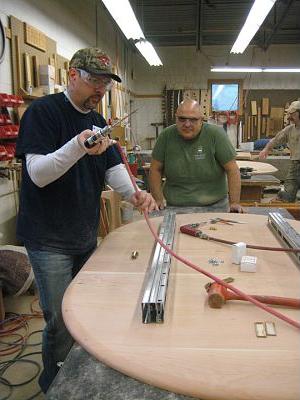When it Comes to Eye Safety, a Sliver of Knowledge Can Make All the Difference
Last week, I completed a week-long woodworking apprenticeship at Thos. Moser Cabinetmakers in Auburn, Maine. Woodworking is my creative outlet, but several years ago my tools were stolen so I set the hobby aside and focused on building my practice. Thos. Moser’s Customer in Residence program provides amateurs an opportunity to work and learn alongside a master cabinetmaker while creating a signature Thos. Moser design — in my case, the Aria dining table in cherry. In so many respects besides woodworking, this was an invaluable learning experience for me, which I will blog more about in coming weeks. However, it also provided me with a gratifying teaching opportunity.

On graduation day, attended by all the cabinetmakers, I was asked to give a brief safety talk. Thos. Moser has safety protocols in place and they are taken seriously. I gave my spiel, stressing that if a splinter has punctured and penetrated the eyeball, it should not be removed. The temptation is to pull it out, but doing so can cause irreparable eye damage and permanent vision loss. Barbs on the splinter can attach to the jelly-like substance in the eye called the vitreous humor, and the jelly might come out along with the splinter were you to pull it out. From a medical standpoint, this is even worse than it sounds.
After my talk, three people thanked me and said they had not known not to pull out a splinter. That meant a lot to me. I gained so much from my experience at Thos. Moser that I am glad to have left them with a “sliver” of knowledge that could potentially save their sight.
What to do if you get a splinter or foreign body in your eye
If a splinter of wood or metal, or any other foreign body, has punctured and penetrated the eye, seek medical attention immediately and do not attempt to remove it. Do not bandage or put pressure on the eye. Use a Dixie type of paper cup to cover and protect the eye until you’re seen by a medical professional. Tape or gauze can be wrapped around the head to hold the cup in place.
A non-penetrating object or sliver on the surface of the eye often can be safely removed at an eyewash station or by rinsing the eye with lukewarm water. Fill a sink basin, submerge your face and open your eyes underwater. Move your eyes around to dislodge the foreign body. If the object is on the white part (sclera) of the eye or inside the lower lid and rinsing is ineffective, wet the tip of a twisted piece of tissue and gently touch the end to the object. The object should cling to the tissue and come out. You can also loosen the cotton on a cotton swab, wet it and gently make contact with the foreign body. If the object won’t come out, seek medical attention. Continued inexpert attempts to remove it can cause eye damage.
How to tell if a foreign object has penetrated the eye
If an object has punctured and penetrated the eye, it will move along with your eye when you shift your gaze. By contrast, an object on the surface of the eye will tend to float around on the tear film. If in doubt, do not attempt to remove the object. Seek immediate medical attention.
Use protective eyewear to protect the eyes in the first place
When working with power tools, always use protective eyewear such as safety glasses, goggles and face shields. Next week, I’ll tell you how to select the right protective eyewear for your occupation or pastime. And in coming weeks, I’ll address different aspects of occupational eye safety, including protecting against computer vision syndrome.
Dr. Jeff Pinkerton
I care for you.
Comments are closed.

[…] common yet far more serious eye injury is when a foreign object such as a sliver gets embedded in the eye. This is usually very painful and requires a doctor’s attention. Again, go over these steps with […]